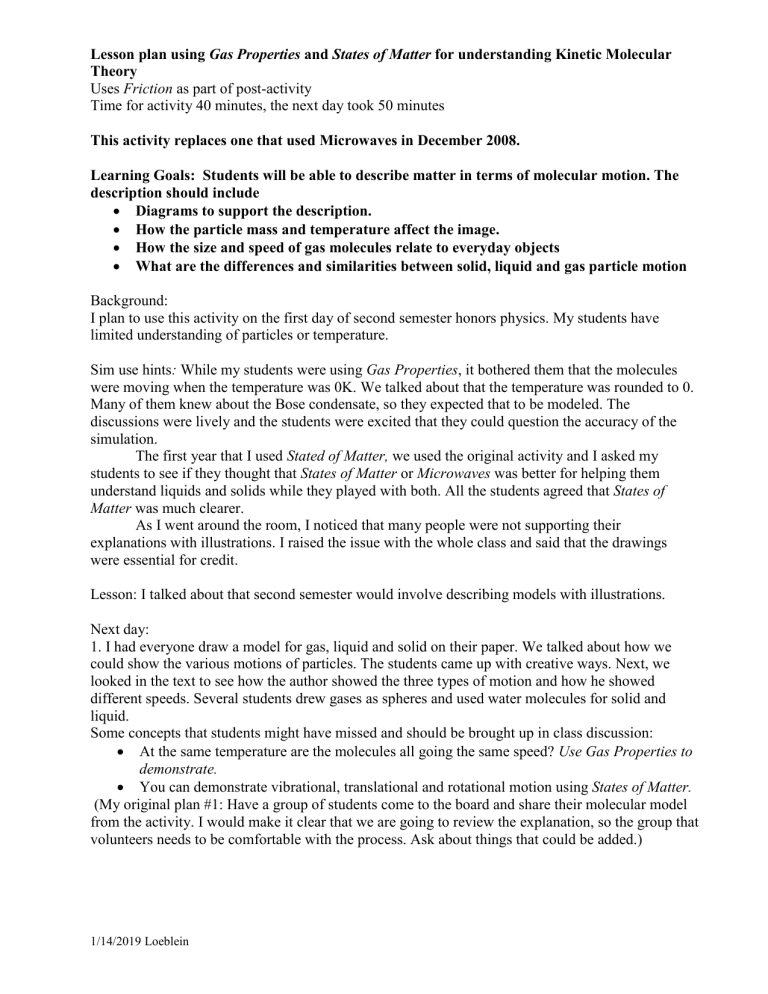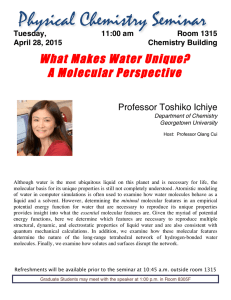Lesson plan for understanding KMT
advertisement

Lesson plan using Gas Properties and States of Matter for understanding Kinetic Molecular Theory Uses Friction as part of post-activity Time for activity 40 minutes, the next day took 50 minutes This activity replaces one that used Microwaves in December 2008. Learning Goals: Students will be able to describe matter in terms of molecular motion. The description should include Diagrams to support the description. How the particle mass and temperature affect the image. How the size and speed of gas molecules relate to everyday objects What are the differences and similarities between solid, liquid and gas particle motion Background: I plan to use this activity on the first day of second semester honors physics. My students have limited understanding of particles or temperature. Sim use hints: While my students were using Gas Properties, it bothered them that the molecules were moving when the temperature was 0K. We talked about that the temperature was rounded to 0. Many of them knew about the Bose condensate, so they expected that to be modeled. The discussions were lively and the students were excited that they could question the accuracy of the simulation. The first year that I used Stated of Matter, we used the original activity and I asked my students to see if they thought that States of Matter or Microwaves was better for helping them understand liquids and solids while they played with both. All the students agreed that States of Matter was much clearer. As I went around the room, I noticed that many people were not supporting their explanations with illustrations. I raised the issue with the whole class and said that the drawings were essential for credit. Lesson: I talked about that second semester would involve describing models with illustrations. Next day: 1. I had everyone draw a model for gas, liquid and solid on their paper. We talked about how we could show the various motions of particles. The students came up with creative ways. Next, we looked in the text to see how the author showed the three types of motion and how he showed different speeds. Several students drew gases as spheres and used water molecules for solid and liquid. Some concepts that students might have missed and should be brought up in class discussion: At the same temperature are the molecules all going the same speed? Use Gas Properties to demonstrate. You can demonstrate vibrational, translational and rotational motion using States of Matter. (My original plan #1: Have a group of students come to the board and share their molecular model from the activity. I would make it clear that we are going to review the explanation, so the group that volunteers needs to be comfortable with the process. Ask about things that could be added.) 1/14/2019 Loeblein Lesson plan using Gas Properties and States of Matter for understanding Kinetic Molecular Theory Uses Friction as part of post-activity Time for activity 40 minutes, the next day took 50 minutes 2. They wrote down: theory, fact, model, law, and principal. Understanding these is a thread for my class. During second semester, we focus on the students understanding modeling. We reviewed the meaning of each. 3. I also used the Friction sim. First, have the students rub their hands together and write down what they think is happening on a molecular level. Then open the sim and I gently rub the two layers together so that the students can see the rise in temp and the increase in molecular motion. If you rub too vigorously or have the layers too close together, the molecules have so much energy that they leave the surface. This is probably distracting. 4. Give everyone a rubber band. Have them get an idea of its temp by touching to upper lip. Then, have them vigorously stretch and test temp again. It should feel warmer. Have them write what they think is happening on a molecular level. 5. We talked about different ways we know how to change temperature. (haven’t studied PV work yet) 6. My text assumes that the students know the Kinetic Molecular Theory (KMT). I’ll put this on an overhead and we’ll compare what we wrote to the “textbook” version. 1. Matter is made up of particles having negligible mass are in constant random motion (vibrate, rotate, translate) 2. The particles are separated by great distances 3. The particles collide perfectly elastically (there are no forces acting except during the collision) 4. The temperature of a substance is related to the molecular velocity. 7. We talked about how thermal equilibrium is reached through molecular collisions. 8. There is a “quick lab” in our text that we did. You have three water containers (hot, cold and room temperature). They put both hands in the room water for a few minutes, and then they place one hand in hot and one in cold. They write a paragraph explaining what they feel and include a molecular model. 9.There are some clicker questions too. 1/14/2019 Loeblein



